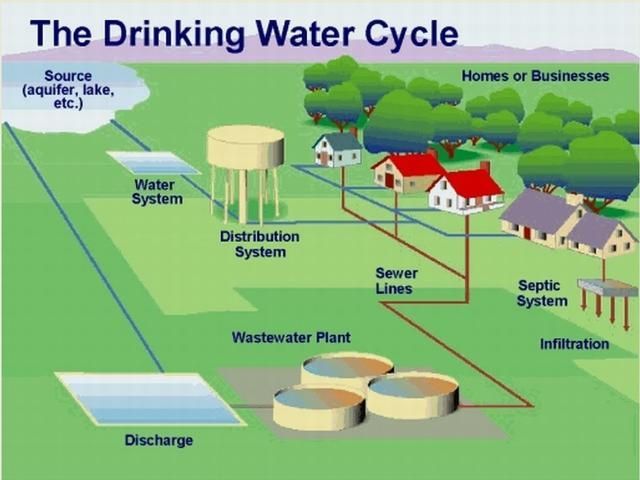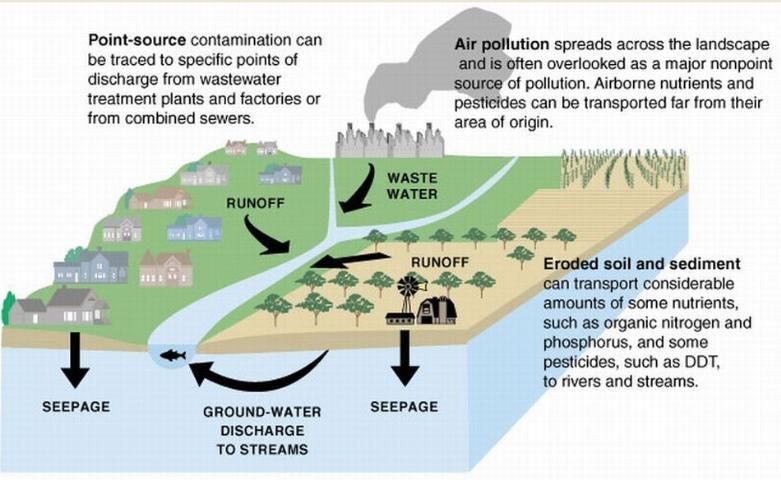Introduction and Purpose
Do you ever wonder about the source and quality of the water that comes into your home via the public water supply? Oftentimes, we take for granted that when we turn on the tap, water will flow and that the water we drink will be clean, safe, and reliable. Most of us don't think about where the water comes from, let alone the effort required to deliver clean water. The purpose of this publication is to familiarize homeowners in the Tampa Bay region with the local sources of drinking water, potential pollution sources, and actions that can protect the quality of the local drinking water supply.
Sources of Drinking Water in the Tampa Bay Region
Drinking water in the Tampa Bay region comes from a vast below-ground aquifer system (groundwater), as well as from surface water supplies such as lakes, reservoirs, and streams. In 2019, approximately 57% of the region's drinking water came from groundwater sources, 4% from desalinization, and 39% from surface water (e.g., Hillsborough River, Alafia River, and Tampa Bypass Canal) (Tampa Bay Water 2024).
Most homeowners in the Tampa Bay region obtain their drinking water from the public supply. Figure 1 shows an example of a public water system. In the Tampa Bay region, Tampa Bay Water is the wholesale water supplier to Hillsborough, Pasco, and Pinellas counties and the cities of Tampa, St. Petersburg, and New Port Richey, although the city of Tampa did not purchase water from Tampa Bay Water in 2016. During the 2022 fiscal year (Oct 1, 2021 through September 30, 2022), Tampa Bay Water delivered an average of 188.33 million gallons of drinking water per day from 13 regional well fields, the Hillsborough River, the Alafia River, the Tampa Bypass Canal, and the Tampa Bay Desalinization Plant. This water is delivered to the member governments through 295 miles of pipeline in the region (Tampa Bay Water 2023). More information about the current supplies of water can be found at the Tampa Bay Water's website (https://www.tampabaywater.org).

Credit: US EPA
Potential Sources of Drinking Water Contamination
In the Tampa Bay region, regional water supply sources were once located in relatively remote locations. However, population growth and land development in the region have situated these drinking water sources in close proximity to developed urban and suburban areas. As a result, the risk for contamination of drinking water sources is increasing. Potential drinking water pollutants originate from point sources, such as wastewater treatment plants and industrial outflows, and non-point sources, such as runoff or leachate (water that moves through the soil to the groundwater) from urban, suburban, industrial, and agricultural areas (Figure 2). Some of the potential contaminants of drinking water supplies include:
Microorganisms
Most microscopic organisms are not harmful, but some, such as E. coli (a bacteria) and Cryptosporidium (a protozoan) can make you sick if ingested through drinking water. The most common sources of microorganism contaminants in drinking water come from human and animal wastes. Animal sources of microorganisms can be natural wildlife or animal agriculture, while human sources can come from malfunctions in either septic or sanitary sewer systems.
Radioactive Elements
Some contaminants, such as radon gas, can emit radioactivity. Radon is a naturally occurring gas that can be dissolved in water. The source of radon in drinking water is the breakdown of rocks that contain the gas.
Inorganic Contaminants
Examples of inorganic contaminants include lead, arsenic, nitrate, and phosphate. Lead can come from degraded water pipes, while nitrate and phosphate may come from the use of fertilizers or animal wastes left on the soil in agricultural and urban areas. Regional mining operations may also be a source of phosphates. Lead contamination of drinking water has become a major concern after lead contamination of public drinking water in certain municipalities in the United States, such as Flint, Michigan. More information about lead in drinking water can be found at: https://www.epa.gov/ground-water-and-drinking-water/basic-information-about-lead-drinking-water and specific information related to lead in drinking water supplies in the Tampa Bay region is available at https://www.tampabaywater.org/quality/water-quality-concerns/lead-2/.
Organic Contaminants
Organic chemicals can originate from chemical spills or leaking storage tanks. For example, gasoline or oil may be spilled on the ground or leak from underground storage tanks. Pesticides that are used in agricultural and urban areas can also be a source of organic contaminants.
Pharmaceuticals and Personal Care Products
Medications that are flushed down the drain and/or excreted from human bodies may find their way into the drinking water supply, as can products like anti-microbial soaps, sunscreens, and cosmetics.

Credit: USGS
Government Actions to Protect Drinking Water
In Florida, the Department of Environmental Protection (DEP) is responsible for regulating public water systems, which are defined as any facility that provides drinking water to at least 25 people or 15 connections, at least 60 days per year. The Florida Department of Environmental Protection requires that levels of potential contaminants in water delivered through the public supply do not exceed levels set by the US Environmental Protection Agency. This is done to ensure that the water delivered through the public supply is clean and safe. Each year, Tampa Bay Water performs thousands of water tests to ensure the quality of the water delivered through its system. Tampa Bay water provides an annual water quality report online. The 2023 report is available at https://www.tampabaywater.org/wp-content/uploads/2023-Water-Quality-Report.pdf.
In addition to efforts by the Florida Department of Environmental Protection, there are many local government efforts to ensure the safety and reliability of the region's drinking water. For example, county and city governments in the region have passed land development ordinances, acquired sensitive lands near drinking water sources, and reviewed and modified proposals for land development to ensure that wellheads and surface water sources are protected from pollution.
Activities that Help to Protect Drinking Water
There are some simple things that you can do to help protect the local sources of drinking water in your area. Do your part by:
- Using best management practices when fertilizing landscapes to avoid nutrient pollution.
- Limiting pesticide applications.
- Purchasing and using environmentally friendly household chemicals.
- Using all medications and personal care products, and properly disposing of un-used or expired products (never flush medications down the drain).
- Disposing of household chemicals (e.g., paint, motor oil, gasoline, cleaning products, etc.) at designated facilities.
- Washing your car at a professional carwash rather than in your driveway to prevent chemicals from entering surface water and groundwaters.
- Maintaining septic systems by having regular inspections and tank pumping.
- Having unused wells closed by a professional.
- Joining a community environmental group to help spread the word!
Summary
Protection of drinking water sources is important to ensure that the citizens of the Tampa Bay region continue to receive safe, clean, and reliable drinking water. It is important that citizens also do their part to limit pollution and wasteful use of the water supply. Simple things like proper use and disposal of fertilizers and household chemicals can go a long way to help keep our drinking water clean.
References
Tampa Bay Water. 2024. 2023 Annual Report. https://www.tampabaywater.org/wp-content/uploads/2023-Water-Quality-Report.pdf. Accessed December 4, 2024.
Tampa Bay Water. 2023. 2022 Year in Review. https://www.tampabaywater.org/wp-content/uploads/Year-in-Review-2022.pdf. Accessed December 4, 2024.
US EPA. 2002. Consider the source: A pocket guide to protecting your drinking water. United States Environmental Protection Agency, Washington, D.C. Available at https://www.epa.gov/sites/default/files/2015-10/documents/guide_swppocket_2002_updated.pdf. Accessed December 4, 2021.
US EPA. 2004. Drinking water contaminants. United States Environmental Protection Agency, Washington, D.C. Available at http://permanent.access.gpo.gov/lps21800/www.epa.gov/safewater/hfacts.html. Verified December 4, 2021.